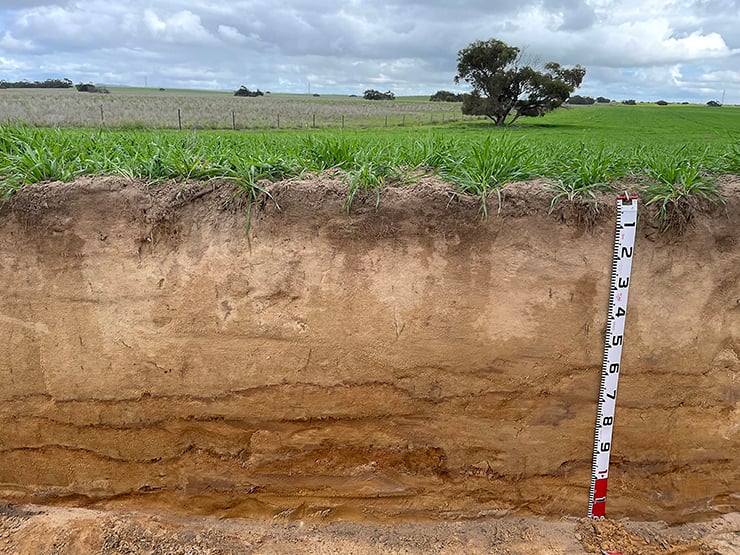Tillage and compost combat soil issues

Arran and Anika Loechel with their children.
Arran Loechel is reaping the benefits of deep-tillage strategies to combat water-repellent sands at his Coomandook, SA, property.
He took over the reins of ‘Booderoo’ after swapping his career as a fencing contractor in favour of farming when the opportunity to manage came up. He's now transitioned into a part owner of the sheep and cropping property.
“I’d been very interested in running my own farm for years, so the offer to buy into a sheep and lamb business was hard to turn down,” Arran said.
In 2019, Arran volunteered to host a demonstration site as part of the 'Improved grazing production on non-wetting sands' project after experiencing several years of poor pasture growth.
“Nothing was growing, the soil was repelling water and we were willing to give anything a go,” he said.
Identifying soil constraints
A 24ha paddock at Booderoo was selected as the demonstration site – the area was characterised by deep sandy soils and a heavy loam flat on the southern end, where limestone is present from 30cm.
Soil sampling in 2021 confirmed the paddock was moderately water repellent and potassium deficient.
The deep sand had high soil strength below 25cm, indicating compaction, as well as low nutrient retention throughout.
It supported Arran’s observations of the declining quality of lucerne planted in the paddock.
“In the past, we used a Plozza Plow (a modified 5GP John Shearer one-way plough) on the deep sand with varied success, so I was interested in testing other strategies to treat the high soil strength.”
The project team identified deep tillage as the best option to overcome compaction and reduce water repellence at Booderoo. Locally-acquired aged piggery manure and bedding straw was also used to boost fertility and lower the risk of erosion post-amelioration.

Booderoo soils.
Treatment process and cost
To understand the most effective pasture production strategy on water-repellent sands, the paddock at Booderoo was divided up into 10 plots, which will be monitored until 2025.
In autumn 2022, treatments were applied on the 10 plots to:
- dilute water-repellent surface soil layers
- treat deep soil compaction
- treat nutrient deficiencies using mineral fertiliser and aged piggery manure.
Grazing
Cereal rye was chosen for its reliability as it’s typically able to flourish in low-fertility, deep sandy soils. Vetch and Balansa clover were chosen as a base for its nitrogen and protein supply, and a grazing brassica was selected as an addition to increase diversity in both protein intake and root architecture underground.
Researchers used a Trimble GreenSeeker in July 2020, which indicated enhanced growth in all the manure-treated plots, but only when combined with deep tillage.
In the absence of manure, deep rip was the only deep-tillage treatment that performed well.
On 11 August 2022, 4ha of the trial site was crash grazed for 24 hours with 1,900 dry sheep equivalent (DSE).
Dry matter (DM) measured in early September 2022 also showed the three deep-tillage treatments combined with manure to be the highest yielding – adding between 1.8–2.5t/ha of additional DM to the average 1.8t/ha yielded from the plots without manure.
“After grazing in August, the pasture recovered well owing to high spring rainfall,” Arran said.
The November results showed the deep rip paired with soil mixing treatments were the highest producing, with the addition of manure showing an even higher yield. Both yielded more than 6.5t/ha of DM. This was 3t/ha greater than the average of the controlled plots that received no mechanical treatment or soil ameliorants.
This additional yield often came at the expense of dry matter digestibility, but there were no consistent trends in crude protein or metabolisable energy.
At the conclusion of the first year of this project, the results equated to additional gross income of more than $200/ha at Booderoo from a grazing perspective – however cost of amelioration has not yet been factored.
Recent results
Following the first year of treatment, the cereal rye was harvested for seed and was grazed for the third time over the 2022–23 summer.
“We ended up having a bit of pasture for grazing in our other paddocks, so we decided to lock up the treatment site and let the pasture thicken and green up to utilise it for its seed,” Arran said.
“On Anzac Day, the paddock was sown with an annual fodder crop. Dry conditions after sowing really showed the benefits of overcoming repellence last year.
“The plots where we used the Plozza Plow were all up and away early, while the other treatments were slower to get going.
“We’ve been fortunate in getting lots of rain over the past two years, so I’m really interested to see how the site holds up during the dryer season.”
The demonstration site has since been stocked for another round of grazing and Arran plans to continue to monitor and trial different techniques to address water repellence going forward over the two years remaining in the project.
Arran's three steps to effective pasture production1. Address nutrient deficiencies
2. Overcome compaction
3. Plant new pasture
|



